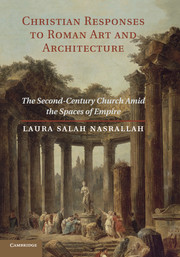 Christian Responses to Roman Art and Architecture
Christian Responses to Roman Art and Architecture Book contents
- Frontmatter
- Contents
- LIST OF FIGURES
- ACKNOWLEDGMENTS
- ABBREVIATIONS
- INTRODUCTION
- PART I FRAMING THE QUESTION, FRAMING THE WORLD
- PART II INTO THE CITIES
- PART III HUMAN BODIES AND THE IMAGE(S) OF GOD(S)
- 5 HOW DO YOU KNOW GOD? ATHENAGORAS ON NAMES AND IMAGES
- 6 WHAT DO WE LEARN WHEN WE LOOK? (PART I) IMAGES, DESIRE, AND TATIAN'S TO THE GREEKS
- 7 WHAT DO WE LEARN WHEN WE LOOK? (PART II) APHRODITE AND CLEMENT OF ALEXANDRIA
- EPILOGUE
- BIBLIOGRAPHY
- INDEX LOCORUM
- INDEX
- References
5 - HOW DO YOU KNOW GOD? ATHENAGORAS ON NAMES AND IMAGES
from PART III - HUMAN BODIES AND THE IMAGE(S) OF GOD(S)
- Frontmatter
- Contents
- LIST OF FIGURES
- ACKNOWLEDGMENTS
- ABBREVIATIONS
- INTRODUCTION
- PART I FRAMING THE QUESTION, FRAMING THE WORLD
- PART II INTO THE CITIES
- PART III HUMAN BODIES AND THE IMAGE(S) OF GOD(S)
- 5 HOW DO YOU KNOW GOD? ATHENAGORAS ON NAMES AND IMAGES
- 6 WHAT DO WE LEARN WHEN WE LOOK? (PART I) IMAGES, DESIRE, AND TATIAN'S TO THE GREEKS
- 7 WHAT DO WE LEARN WHEN WE LOOK? (PART II) APHRODITE AND CLEMENT OF ALEXANDRIA
- EPILOGUE
- BIBLIOGRAPHY
- INDEX LOCORUM
- INDEX
- References
Summary
Throughout the book we have been asking what claims regarding ethnicity, paideia, piety, and power are made through words and images. How are people represented? How do they represent themselves? And who, gently or not so gently, points to the gap between the thing and its representation? The city squares of the Greek East were crammed with statuary of gods and elites. From the coin in your pocket – if you were so lucky – to the sculptures that gazed down on you in the temple or the agora, emperors and elites made statements about their piety, their knowledge of culture, and their likeness to the gods.
The Christian writer Athenagoras enters into this landscape. He lives in a world where a woman at death is depicted as a naked Aphrodite/Venus, as we shall see in Chapter 7, and where emperors are gods before they die and are depicted as rising to the heavens at death, as we have already seen. Athenagoras's Embassy, purportedly addressed to the emperors, reverses the terms of the visual argument that seeks to overwhelm anyone who walks the public spaces of empire: that humans, including the emperors, are or are becoming gods.
Both Justin and Athenagoras, as they address the imperial family, call the emperors to task for their inability to be what they are named. That is, Justin and Athenagoras protest a poor match between the name or the noun (to onoma) and the thing that it represents.
- Type
- Chapter
- Information
- Christian Responses to Roman Art and ArchitectureThe Second-Century Church amid the Spaces of Empire, pp. 171 - 212Publisher: Cambridge University PressPrint publication year: 2010


